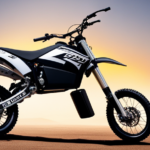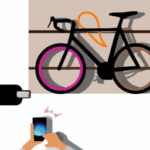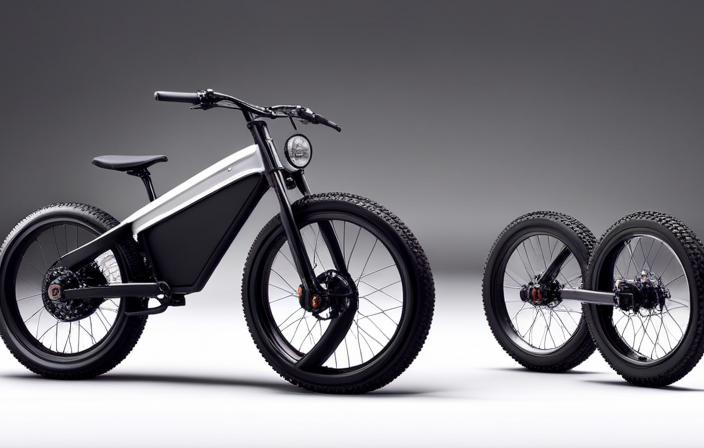Have you ever thought about the duration it takes to charge an electric bike? Just like fueling up a rocket before takeoff is crucial, charging an electric bike is essential for a seamless and uninterrupted ride.
In this article, we’ll delve into the technicalities of electric bike batteries, explore different charging options, and reveal the average charging times for various models.
So buckle up and get ready to power up your knowledge on electric bike charging!
Key Takeaways
- The charging time of an electric bike depends on the battery size and charger power output.
- Small batteries (250Wh) typically take 2-3 hours to charge, while larger batteries (500Wh) can take 4-6 hours.
- Different electric bike models have different charging requirements, so it is important to consult the bike’s manual or manufacturer’s guidelines.
- Mountain bikes generally have larger batteries and longer charging times (4-8 hours), while commuter bikes have smaller batteries and shorter charging times (around 3-5 hours).
Understanding Electric Bike Batteries
You may be wondering how long it takes for an electric bike to charge its battery. Understanding electric bike batteries is crucial for efficient charging and overall performance. Electric bike battery maintenance plays a significant role in ensuring optimal charging times.
Regularly checking the battery’s condition and keeping it clean can help troubleshoot any charging issues. It’s important to note that the charging time varies depending on the battery capacity and the charger’s power output. Typically, it takes around 3 to 6 hours to fully charge an electric bike battery. However, some fast-charging options can reduce this time to just 1 to 2 hours.
Now that we have a better understanding of electric bike battery charging, let’s explore the different charging options available.
Charging Options for Electric Bikes
There are various options available for charging electric bikes. One of the most common options is to use a standard wall outlet. This can take anywhere from 4 to 8 hours to fully charge the battery, depending on the size and capacity of the battery.
Another option is to use a dedicated electric bike charging station. These charging stations are designed to provide a higher voltage and amperage, allowing for faster charging times. This is especially advantageous for those who need to charge their electric bike quickly and don’t have hours to wait for a full charge. Fast charging options can typically charge an electric bike battery to 80% capacity in just 1 to 2 hours.
With these charging options in mind, let’s now explore the average charging times for electric bikes.
Average Charging Times for Electric Bikes
To charge an electric bike, it typically takes several hours using a standard wall outlet or significantly less time using a dedicated electric bike charging station. The charging speed can vary depending on several factors that affect the charging time.
These factors include:
-
Battery Capacity: The larger the battery capacity, the longer it will take to charge. A higher-capacity battery may require overnight charging, while a smaller battery can be fully charged in a few hours.
-
Charging Voltage: Electric bikes can be charged at different voltages. Higher voltage chargers can charge the battery faster, reducing the overall charging time.
-
Charger Efficiency: The efficiency of the charger also plays a role in the charging speed. A more efficient charger will convert more electricity into usable energy, reducing charging time.
-
Battery Health: The condition of the battery affects its charging speed. A well-maintained battery will charge faster than one that is degraded or nearing the end of its lifespan.
Considering these factors, it is important to choose the right charging option and follow proper charging etiquette and best practices to ensure optimal charging efficiency and battery longevity.
Charging Etiquette and Best Practices
Start by following proper charging etiquette and best practices to ensure optimal charging efficiency and battery longevity. When charging at public places, it’s important to be considerate of other users. Avoid hogging charging stations by promptly removing your bike once it’s fully charged. If there are limited charging stations available, try not to charge for longer than necessary to allow others to access the stations. Additionally, be mindful of the charging rate you use, as higher charging rates can put more strain on the battery and reduce its lifespan. When charging at home, it’s recommended to use the charger provided by the manufacturer and avoid using third-party chargers, as they may not be compatible or safe. Remember to always unplug the charger from the outlet when not in use to prevent unnecessary energy consumption. By following these charging etiquette and best practices, you can ensure efficient and safe charging for your electric bike. Transitioning to the next section, let’s explore ways to extend the battery life.
Extending Battery Life
One way to prolong the life of your e-bike battery is by implementing certain strategies. Extending battery life is crucial for maximizing the efficiency and longevity of your electric bike.
One key strategy is to avoid fully discharging the battery regularly. Instead, try to keep the battery level between 20% and 80% for optimal performance.
Additionally, it is recommended to avoid leaving the battery fully charged for extended periods, as this can cause degradation over time.
Another helpful tip is to charge the battery at a moderate temperature, as extreme heat or cold can negatively impact its lifespan.
Lastly, using the appropriate charger and following the manufacturer’s guidelines can further optimize charging efficiency.
By implementing these strategies, you can extend the life of your e-bike battery and enjoy longer rides.
Speaking of charging infrastructure for electric bikes…
[Transition to the subsequent section about ‘charging infrastructure for electric bikes’]Charging Infrastructure for Electric Bikes
When it comes to the charging infrastructure for electric bikes, there are a few key points to consider.
First, the availability of charging stations is crucial for electric bike riders, as it determines how convenient it is to charge their bikes.
Additionally, charging networks and apps play a significant role in providing riders with information on the nearest charging stations and their availability.
Lastly, future developments in charging infrastructure are expected to include advancements in charging speed and efficiency, as well as the integration of renewable energy sources for a more sustainable charging process.
Availability of charging stations
If you want to charge your electric bike, you’ll easily find plenty of charging stations available. In urban areas, the charging infrastructure for electric bikes is more developed, with a higher concentration of charging stations. These stations are usually strategically placed in convenient locations such as parking lots, shopping centers, and public transportation hubs.
However, the availability of charging stations can be a challenge in remote locations, where the infrastructure is not as developed. In these areas, finding a charging station might require more planning and research. Nevertheless, the growing popularity of electric bikes has led to an increase in the number of charging stations across various regions.
As we move on to the next section about charging networks and apps, it’s important to consider how these charging stations are connected and accessible through digital platforms.
Charging networks and apps
To easily locate charging stations for your electric bike, you can rely on charging networks and apps. These networks and apps have revolutionized the way electric bike users find and access charging stations.
With the charging network expansion, more and more charging stations are being added to these networks, making it easier for riders to find a nearby charging point.
The benefits of using charging apps are numerous. They provide real-time information on the availability and status of charging stations, helping riders plan their routes accordingly. Additionally, these apps often include features like navigation and payment options, further enhancing the user experience.
As electric bike technology continues to advance, we can expect even more innovations in the charging infrastructure, making it more convenient and accessible for riders.
Future developments in charging infrastructure
Now let’s take a look at the future developments in charging infrastructure for electric bikes.
As technology continues to advance, we can expect to see some exciting innovations in this field. One area of focus is the improvement of charging networks and apps, making them more efficient and user-friendly.
Additionally, wireless charging is an emerging trend that holds great promise. Imagine being able to simply park your electric bike in a designated area and have it wirelessly charge without any physical connection. This technology is currently being developed and tested, and it could revolutionize the way we charge our bikes.
In the near future, we might see charging stations equipped with wireless charging pads, providing a convenient and hassle-free charging experience. With these advancements on the horizon, charging your electric bike on the go will become even more seamless and effortless.
Charging Your Electric Bike on the Go
When you’re on the go, it won’t take you long to charge your electric bike. Thanks to advancements in portable charging solutions, you can charge your electric bike while traveling, ensuring that you never run out of battery power.
Portable charging options, such as compact chargers or solar chargers, allow you to plug in your electric bike wherever you are, whether it’s at a coffee shop, a park, or even on a camping trip. These solutions are lightweight and easy to carry, making it convenient to charge your electric bike wherever you go.
With these portable charging options, you can quickly top-up your bike’s battery and continue on your journey without any worries.
Now, let’s explore the relationship between charging time and riding time.
Charging Time vs. Riding Time
The amount of time it takes to charge your electric bike directly affects how long you can ride it. The charging time of an electric bike varies depending on the battery size and the charger’s power output. Generally, larger batteries take longer to charge. For example, a small battery with a capacity of 250Wh may take around 2-3 hours to fully charge, while a larger battery with a capacity of 500Wh may take around 4-6 hours. It’s important to consider the riding time limitations when planning your trips. If you have a shorter charging time, you may need to take breaks more frequently to recharge your battery. On the other hand, if you have a longer charging time, you can ride for a longer duration before needing to charge again. Understanding the impact of battery size on charging time is crucial for managing your riding time effectively. Moving on to the next section about charging considerations for different electric bike models…
Charging Considerations for Different Electric Bike Models
When it comes to charging electric bikes, different models have different requirements.
For example, mountain bikes and commuter bikes may have varying charging needs due to their distinct features and usage.
Additionally, e-bikes with multiple batteries or high-performance features may require special considerations during the charging process.
It is also important to consider the compatibility of third-party chargers with different electric bike models to ensure efficient and safe charging.
Charging requirements for different types of electric bikes (e.g., mountain bikes, commuter bikes)
To charge your electric bike, you’ll need to consider the specific requirements for different types of bikes, such as mountain bikes and commuter bikes.
Mountain bikes usually have larger batteries due to the increased power needed for off-road riding. As a result, they generally require longer charging times compared to commuter bikes. The charging time for a mountain bike can vary depending on the battery capacity and the charger’s output. It can range from 4 to 8 hours or even more for some high-capacity batteries.
On the other hand, commuter bikes typically have smaller batteries and can be charged in around 3 to 5 hours.
It’s important to consult your bike’s manual or manufacturer’s guidelines for the exact charging requirements.
Now, let’s explore the special considerations for e-bikes with multiple batteries or high-performance features.
Special considerations for e-bikes with multiple batteries or high-performance features
If you have an e-bike with multiple batteries or high-performance features, there are some special considerations to keep in mind. Charging multiple batteries can be more complex, but it’s not overly complicated. Many e-bikes with multiple batteries come with a charging system that allows you to charge both batteries simultaneously, reducing charging time. However, make sure your charger is compatible with charging multiple batteries at once. High-performance e-bike features may require a higher wattage charger, so check the manufacturer’s recommendations. This will help ensure safe and efficient charging of your batteries. Now, let’s discuss compatibility with third-party chargers…
Compatibility with third-party chargers
Compatibility with third-party chargers can be a concern when charging an e-bike with multiple batteries or high-performance features. While third-party chargers may offer convenience and potentially lower cost, there are certain risks involved.
One of the main concerns is the compatibility of the charger with the specific battery and bike model. Using an incompatible charger could result in damage to the battery or the bike’s electrical system. Additionally, third-party chargers may not have the same safety features as the original charger, such as overcharge protection or temperature monitoring.
On the other hand, using a compatible and reliable third-party charger can have its benefits, such as faster charging times or additional features. It is important to carefully research and choose a charger that is recommended by the manufacturer or trusted within the e-bike community.
Moving on to the next section about FAQs: common questions about electric bike charging…
FAQs: Common Questions About Electric Bike Charging
Once you plug it in, it won’t take long for your electric bike to charge. The charging speed and efficiency of an electric bike can vary depending on factors such as battery capacity and charger specifications. Generally, the charging time for an electric bike ranges from 3 to 6 hours.
However, it’s important to note that using third-party chargers may affect the charging speed and efficiency. Some third-party chargers may not be compatible with your electric bike’s battery or may not provide the optimal charging voltage, which can result in longer charging times or even damage to the battery.
To ensure the best charging experience, it is recommended to use the charger provided by the manufacturer or a charger specifically designed for your electric bike model.
Frequently Asked Questions
Can I use a regular power outlet to charge my electric bike?
Yes, you can use a regular power outlet to charge your electric bike. However, it is important to note that you should avoid using an extension cord for charging an electric bike and should not charge it in the rain.
Is it safe to leave my electric bike charging overnight?
It is not safe to leave an electric bike charging overnight due to the dangers of overcharging and potential fire hazards. It is important to monitor the charging process and unplug the bike once it is fully charged.
Can I use a fast charger to reduce the charging time of my electric bike?
Using a solar charger for my electric bike is worth it. Investing in a portable charger is a smart decision as it can significantly reduce charging time. Plus, it provides convenience and flexibility for charging on the go.
How often should I charge my electric bike’s battery?
The ideal charging frequency for an electric bike’s battery depends on usage and battery type. Charging too frequently can shorten battery lifespan, while infrequent charging can lead to deep discharges, reducing overall battery capacity.
Is it possible to overcharge an electric bike’s battery?
Overcharging an electric bike’s battery poses risks such as reduced battery life and performance. It’s important to avoid leaving the bike plugged in for extended periods. Optimal charging time varies depending on the battery type.
Conclusion
After diving deep into the world of electric bike charging, I’ve come to understand that the time it takes to charge these fantastic machines can vary.
From a quick zap to a leisurely recharge, electric bike charging is a process that requires patience and planning.
By following charging etiquette and best practices, you can extend your battery life and enjoy longer rides.
Whether you’re charging at home or on the go, it’s important to consider the specific needs of your electric bike model.
So go ahead, charge up and hit the road with confidence!
















